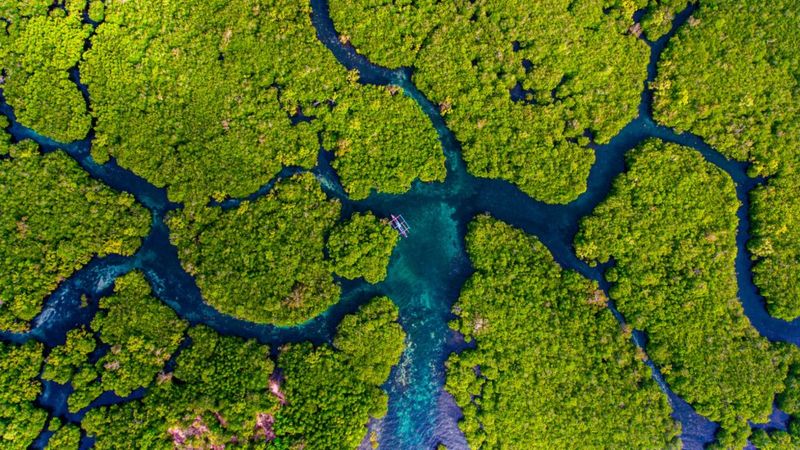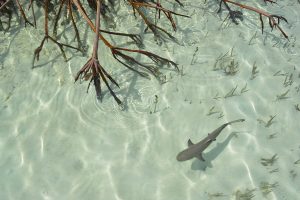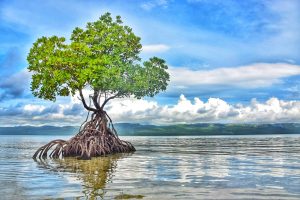Imagine feeling the ambiance laden with the aroma of rich silt and salt while spume of while-veiled waves slowly making their way through obstacles to the shore. Those obstacles, the thick tangles of roots anchored to the muddy, water-logged soil belong to none other than the guardians of the coasts, the mangroves. These bountiful ecosystems lay along the coastlines within the tropic or subtropic latitudes. Did you know that mangrove is the only tree that grows in coastal saline/brackish water? These halophytes support high levels of imperiled, vibrant biodiversity as well.
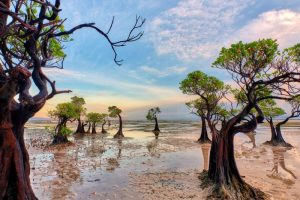
A Dynamic Ecosystem
Crammed between the terrestrial and marine environments mangroves face challenges that pave the way to evolve, unlike other woody trees or shrubs. Mangroves endure powerful waves crumpling between tides and contrasting the nature of the climate with heavy rainfalls and droughts. With roots submerged in water-logged soils, mangroves gain low oxygen supply and varying levels of freshwater supply due to fluctuations of both freshwater and marine water supply. Obviously, these spectacular ecosystems entail exceptional adaptations to survive and thrive under those conditions.
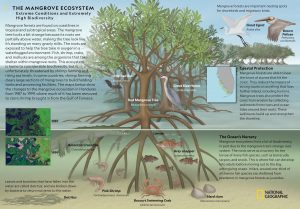
Needless to say, that these vigorous ecosystems are blessed with sundry communities of species muddled up due to the miscellaneous conditions offered by the mangrove forests. Mangrove species adapt in a broadway determined by diverse gradients of salinity, lagoon ambiance, lengths of inundation, tidal fluctuation, and severity of droughts inclusive of others.
A Unique, Special, and Vulnerable Ecosystem
Mangrove forests are considered rare as they represent less than 1% of ubiquitous tropical forests and less than 0.4% of the total global forestation. Mangrove forests are indispensable and productive systems which play a key role in mitigation of global warming and climate change. Due to unsustainable coastal developments/infrastructure, irresponsible fishing, and aquaculture, clear-felling for timber, climate change, the infestation of pests; mangrove forests face both man-made and natural.
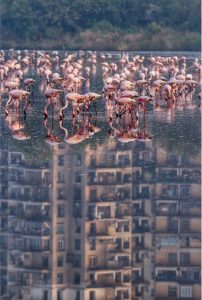
As of 2015, July 26th was declared the International Day for the Conservation of the Mangrove Ecosystem, also known as World Mangrove Day by UNESCO. The Day aims to support the conservation of mangroves worldwide while raising awareness of the necessity of mangrove ecosystems. UNESCO has included mangrove conservation in their initiatives; Man and the Biosphere Programme (MAB), International Blue Carbon Initiative, World Heritage Sites, UNESCO Global Geoparks to promote mangrove conservation and sustainable management.
“The International Day for the Conservation of the Mangrove Ecosystem signifies the value of mangroves as the foundation for the coastal life and advocates for support and awareness of the communities dependent on their conservation. The Day also serves as an opportunity to reflect on our personal commitment by all for a sustainable future.” – Audrey Azoulay, Director-General of UNESCO, on the occasion of the International Day for the Conservation of the Mangrove Ecosystem
Importance of Mangrove Forests
The ocean, contaminated by the accumulation of debris of all sorts, throws up some of this waste, and these washed-up pollutants fester the mangrove forests as well. Hindered by pollution effluence, mining, logging, industry, and urban developments, the Earth has already lost more than a quarter of mangrove forests in the past 50 years.
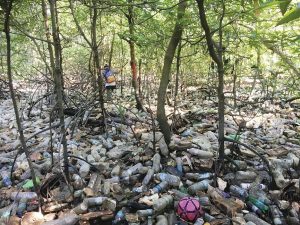
Natural causes such as erosion and storms also accelerate the deterioration of mangroves. Although these threats are declining lately, conservation and restoration of mangroves is a timely requisite so as to protect these ecosystems for future generations.
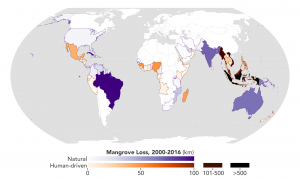
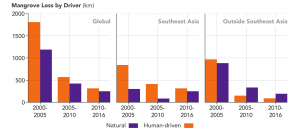
Mangroves play a key role in stabilizing coastal ecosystems, and they are vital to Earth’s carbon cycle. The carbon cycle is the process in which carbon flows from the atmosphere to the Earth and vice versa. The rates of primary production in mangrove ecosystems are equal to those of tropical humid evergreen forests and coral reefs. Mangroves acquire carbon via photosynthesis and assimilate into organic compounds and form new leaves, branches, roots; maintain existing bodies etc.
When they decay, instead of releasing carbon back to the atmosphere, the carbon-rich peat is created. It is known as blue carbon. Blue carbon refers to the preservation of carbon within aquatic ecosystems, in their soils and sediments. Protecting and conserving mangrove coverage to aid ameliorate greenhouse gas emissions. On the other hand, when the mangrove coverage is cut down or deteriorated, the stored carbon releases into the atmosphere and contributes to global warming as a greenhouse gas. Therefore, deforestation of mangroves is considered critical ecologically and socioeconomically.
Mangroves are amphibious trees. Consequently, they have the ability to withstand extreme storms and tidal waves and provide shoreline protection to inland areas. Conversely, mangroves protect the coast from the inland areas.
How can we protect the mangroves?
At present, mangrove rehabilitation and restoration projects are under process. CBEMR mangrove restoration project (Community-Based Ecological Mangrove Restoration) promoted by MAP (Mangrove Action Project) possesses a better approach in methodology than traditional reforestation. CBEMR includes basically 7 steps.
- Understand the mangrove’s autecology
- Understand the normal hydrology patterns
- Assess disturbances
- Develop your hydrological rehabilitation on strategy
- Implementation
- Planting mangrove
- Monitoring
For this process, the involvement of trained personnel ensures the success of the restoration. Besides that, the establishment of sustainable remedies regarding overfishing and sea-level rise, promotion of the importance of these ecosystems especially within coastal communities are actions you can take. It is crucial to take necessary actions with the intention of protecting one of the most important ecosystems on the planet.
Let me lay it on the line; Life on this planet is ticking away and we are bound together in the face of reality. The skyrocketing release of greenhouse gases is leading to a scorched Earth and nothing more, nothing less. What will you do with what remains? Would you still take what nature has conferred us for granted?
Image Courtesies:
- Featured Image: https://bit.ly/3hZHuak
- Content Image 1: https://bit.ly/3iEHrQi
- Content Image 2: Retrieved from National Geographic: https://www.nationalgeographic.org/media/the-mangrove-ecosystem/
- Content Image 3: https://bit.ly/3zADRxh
- Content Image 4: https://bit.ly/3rKo1hf
- Content Image 5: https://bit.ly/3zyK9NY
- Content Image 6: https://go.nasa.gov/2TCtVUW
- Content Image 7: https://go.nasa.gov/3x40dWg
- Content Image 8: https://bit.ly/3y32WRr
References:
- https://en.unesco.org/commemorations/mangroveday
- UNEP-Nairobi Convention/USAID/WIOMSA (2020). Guidelines on Mangrove Ecosystem Restoration for the Western Indian Ocean Region. UNEP, Nairobi, 71 pp. A digital copy of this report is available at: www.nairobiconvention.org/; www.wiomn.org; www.wiomsa.org
- Brown B, Fadillah R, Nurdin Y, Soulsby I & Ahmad R (2014). Case Study: Community Based Ecological Mangrove Rehabilitation in Indonesia. S.A.P.I.EN.S 7(2).

